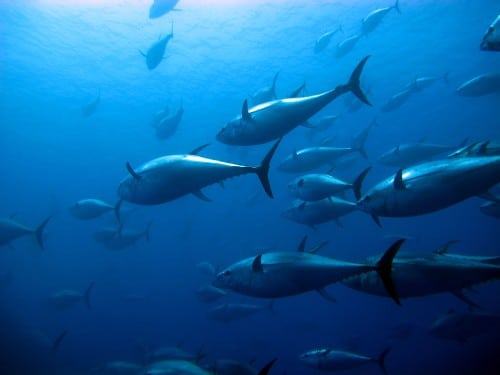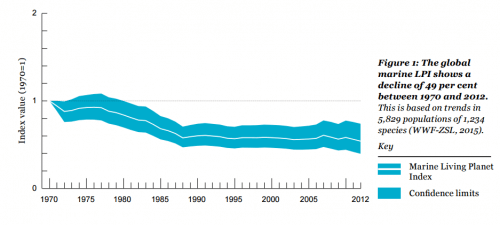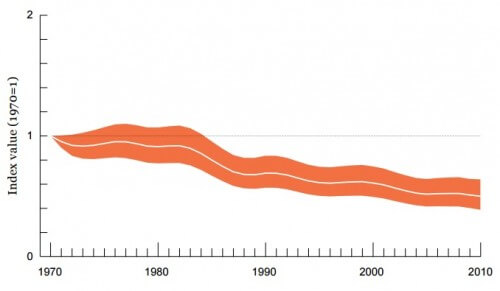A report by the World Wildlife Fund-WWF reveals a sharp decrease in the number and variety of animals in the coral reefs * The chapter dealing with fish indicates a severe decrease in the number of individuals mainly in the fish species used for food and industry

A report by the World Wildlife Fund-WWF reveals a sharp decline in the number and variety of animals in the coral reefs, mangroves and sea grass that support the food chain and provide services of great value to humans, since the fund's first report was written in 1970. When over a quarter Of all the marine creatures that live in coral reefs, and approximately 850 million people benefit from the economy around them through social and cultural services, the loss of coral reefs will also cause extinction on a massive scale and have significant implications for communities.
According to the report, the main drivers for the deterioration trend stem from human activity, and mainly from overfishing, the destruction of habitats and climate change. Although the report paints a bleak picture of the health of the oceans, it also provides solutions and opportunities to reverse the trend. The report highlights the need to protect vital habitats at sea, manage fish stocks in a more sustainable way, improve fishing practices and direct funds to support these vital initiatives.

The previous WWF report, The Living Planet for 2014 He emphasized the alarming state of the natural world, on which our economy and society depend. The Living Planet Index (LPI) reviewed the status of 10.380 populations, including 3,038 vertebrates, and found that the number of individuals in these species decreased by 52% between 1970 and 2010. In other words, the size of the mammal, bird, reptile, amphibian and fish populations has halved in 40 years. Humanity continues to underestimate the needs of nature, threatening our long-term growth and quality of life. As ecosystems shrink, providing the basic needs of the growing human population becomes a greater challenge.
The current report summarizing the state of marine life populations reveals a 49% decrease between the years 1970 and 2012 (see graph 1). This analysis indicates trends in 5,829 populations of 1,234 species of mammals, birds, reptiles and fish. The sample size in this report is double that of the 2014 report, which indicates the poor health of the oceans, and that the extinction rate is greater than previously predicted. The period from 1970 to the mid-XNUMXs experienced the sharpest decline. After that there was some stability, but recently the number of populations started to drop again. The global index also reveals differences between different regions, while the marine populations in the northern latitudes increased, while a strong decrease was recorded in the tropical and subtropical regions.

In the sub-chapter dealing with fish, the editors of the report stated that the sea population they tested was 930 species spread over 1,463 populations used for the subsistence needs of local communities and for commercial uses. The index for all fish essential to the economy shows that the size of the populations dropped by about 50%, between the years 1970 and 2010 (graph 2) out of the population of useful fish, 459 are in danger of extinction. Overexploitation was identified as the main threat in most cases. Other threats included habitat erosion or loss and the effects of climate change.
"Since these fish are important to the life and sustenance of regional economies, the impact on these communities will be even stronger. An example of this can be found in the Scrombidae group of oysters, and the mackerel, tuna and flounder families. The figure for the oysters which included 58 populations of 17 species showed a sharp decline of 74% between the years 1990-1970, but is still ongoing and shows no signs of slowing down.
"The good news is that there are countless opportunities to reverse this process," says Brad Ack, Senior Vice President for Oceans at the World Wildlife Fund. "Stopping the fishing black market, protecting coral reefs, mangroves and other important marine habitats, and trying to reach a deal at the Paris climate conference to reduce carbon emissions. These steps will be good for the oceans, the economy and people. Now is the time to join the US and other powerful countries in leading these important opportunities." Adds Eq.
"The sea is a renewable resource that can satisfy the needs of future generations if the factors causing pressure on it are addressed." says Marco Lambertini, CEO of the WWF. "If we live within the limits of sustainability, the ocean will be able to contribute to food security, vitality and the economy and to the entire natural system.
More of the topic in Hayadan:
- By the middle of the century there will be no fish left in the sea
- In the short term, the fishing must be regulated and the pollution of the sea with sewage must be stopped. In the long term, to save life in the sea, carbon emissions must be stopped - An interview with the chief marine biologist of the Smithsonian Institution
- "In the end only cockroaches will remain" - coverage of the WWF report from 2014 dealing with the state of vertebrates in the world

2 תגובות
Only when the last tree dies, the last river is poisoned, and the last fish is caught, will we understand that you cannot eat money.
It is said:
It's time to:
Instead of controlling the environment for the sake of the human population,
There will be control over the human population for the sake of the environment!